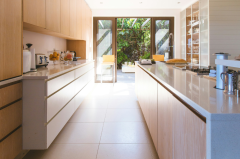We’ve all daydreamed about the “homes of the future” with cutting-edge technology, smart features and futuristic conveniences. Yet, in reality, the most future-proof home isn’t just about tech — it’s about crafting a space that supports you and your family’s health, wellbeing and adaptability for years to come. This is the heart of creating a non-toxic, future-ready home that deeply nurtures the health of those who live within it.
Building a future-proof home starts with intentional design choices. From sustainable materials to adaptable spaces, it’s about ensuring that your home reflects your commitment to both health and the environment.
In this article, we explore practical steps you can take, room by room, to transform your home into a sanctuary of health and sustainability.
What is a healthy, future-proof home?
A future-proof home supports health and wellbeing with choices that favour natural, non-toxic materials and eco-friendly practices. These choices reduce your exposure to harmful chemicals and create a space that adapts to life’s changes. With thoughtful selections, a home becomes a place that grows with you, enhances your health and supports the planet.
Interior stylist Jessica Bellef says, “The materials we surround ourselves with have a profound impact on our health and wellbeing. As the healthier alternative to human-made synthetic fibres, natural materials emit fewer toxins and they contain naturally occurring antibacterial properties. They can help keep you and your family healthy and comfortable all year round in a home that feels fresh and clean.”
Room-by-room guide to a healthy home Kitchen: the heart of the home
The kitchen is one of the most-used rooms in the house, so it’s important to make it a healthy and sustainable space. Here’s how to minimise toxins and create a safe kitchen environment:
Non-toxic cookware and utensils: Ditch traditional non-stick cookware, which can release harmful chemicals when heated. Instead, opt for alternatives like ceramic, stainless steel and cast iron, which are not only safer but also durable, making them great investments for the long term. Cookware brands such as GreenPan and Blu. are crafted with health-conscious families in mind, offering a non-toxic, non-stick cooking experience.
Safe cleaning products: Traditional kitchen cleaners often contain harsh chemicals that can be harmful if inhaled or ingested. Create a simple, effective cleaning routine with natural options such as vinegar, baking soda and lemon. These ingredients are excellent at cutting through grease, killing bacteria and keeping your kitchen surfaces safe for food prep. Look out for brands like Young Living or Vileda, who offer healthy and safe cleaning solutions.
Safe cleaning products: Traditional kitchen cleaners often contain harsh chemicals that can be harmful if inhaled or ingested. Create a simple, effective cleaning routine with natural options such as vinegar, baking soda and lemon. These ingredients are excellent at cutting through grease, killing bacteria and keeping your kitchen surfaces safe for food prep. Look out for brands like Young Living or Vileda, who offer healthy and safe cleaning solutions.
Bathroom: A toxin-free oasis
The bathroom is another area where harmful chemicals and allergens often lurk. Here’s how to turn it into a low-tox space:
Shower curtains and flooring: Many shower curtains are made from PVC, which can release toxic chemicals, especially when exposed to hot water. Look for natural fabrics such as cotton or hemp for shower curtains and consider flooring options like tile or sustainably sourced wood that don’t trap moisture or emit VOCs (volatile organic compounds).
Eco-friendly beauty products and toiletries: Many bathroom products contain parabens, synthetic fragrances and other chemicals that can irritate skin or disrupt hormones. Choose beauty products that are labelled “paraben-free” and “fragrance-free” or seek brands that focus on natural ingredients such as Thankyou, Eco Tan and MV Skintherapy.
Ventilation: Poor ventilation can lead to mould growth, which can greatly impact respiratory health. Install an exhaust fan and open windows when possible to improve airflow. Good ventilation not only keeps the bathroom fresh but also minimises mould, which can trigger allergies and asthma. This is especially important if you live in
a hot or humid climate.
Bedroom: Creating a sanctuary for rest
The bedroom should be a safe haven from everyday pollutants — especially since we spend a third of our lives in bed!
Bedding: Look for bedding made from organic cotton, bamboo or linen, which are free from the chemical finishes often used on synthetic materials. These natural fibres are breathable and light, which help regulate body temperature for a restful sleep.
Mattress choices: Many traditional mattresses contain flame retardants, which can release toxins into the air. Look for organic or natural mattresses ma





